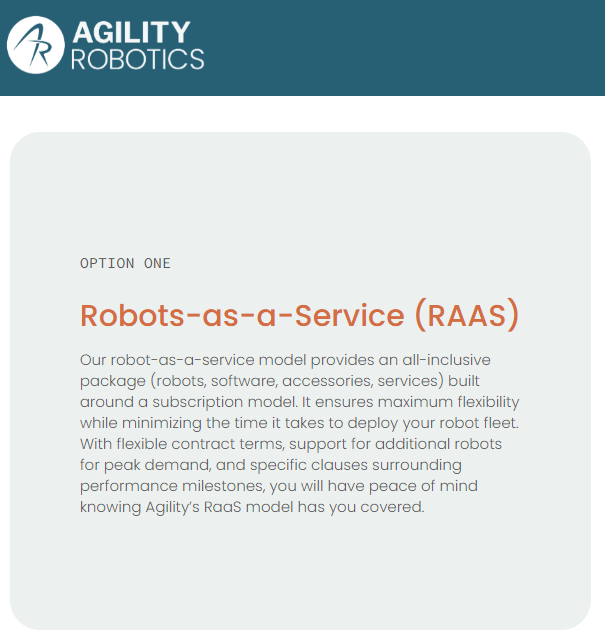The robots are coming.
Actually, they already might be here. We are not discussing futuristic technology. This is something that is in the workforce now.
Naturally, we cannot get ahead of ourselves. The abilities of these machines is still rather limited. When it comes to utility, we are dealing with things specific in nature.
Agility robotics is an example of what we are dealing with. This is a company that is already offering robots-as-a-service, something we are going to see expanding going into the future.
Throughout this year, we have discussed many of the advancements in robotics. In this article will will present the next phase of its evolution.

Robots-as-a-Service
We are dealing with the integration of the digital and physical worlds. Essentially, we are looking at the extension of digital platforms.
Agility Robotics, as we can see from the image above, is now offering their robots for hire. I did not see it on the website but someone had a video where the cost was $30 per hour.
Going with that, albeit unverified, we can see how this could have a tremendous impact upon the labor costs. It is the future and why the robotics industry will explode. As long as there is competency with these platforms, they will be swallowed up by businesses.
Agility offers a full platform. The robots are integrated with software providing the ability to monitor them and change the parameters. It also comes with charging stations and connection to most of the existing business platforms.
Then we have the robots themselves:

Handsome devil isn't it?
The main idea appears to be moving of stuff around.

This is obviously something that could be viewed as dreary work. The idea of lifting containers and moving them around all day long is as exciting as watching paint dry. There is also the risk of injury.
Here is where robots starts to make sense.
The Financial Component
The reason these are going to be swallowed up by businesses is simple: it makes financial sense.
A robot running for 20 hours per day, at $30 per, is $600. This is obviously longer than the average worker, meaning we are dealing with a great deal more output.
Even if the schedule is the same as the workers, $30 is likely less per hour than is being spent. With employees, there is the wage plus benefits. On top of this, we also have, in the US, workman's comp that has to be paid to the state, matching social security, and FICA.
Robots also do not require breaks although they might have to recharge. Of course, this could be timed to coincide with the rest of the plant, charging during lunch or slower times.
The benefits of dealing with a robot are also on display when factoring in humans. A robot doesn't get hungover, have a fight with a spouse, or leave early due to a sick child. The robot doesn't engage in company politics or get into fights with co-workers.
In short, these help to save companies money.
What Agility is doing will be the norm. Platforms will be offered where more than just the robot is provided. As larger entities get involved, there will likely be tasks (or abilities) that can be purchased. The abilities of the robots, as more are in the field, will expand over time.
These things are data collectors. Anything it is doing is being captured and quantified. It is likely there are sensors throughout the bot, monitoring and recording everything that is taking place.
All this data can be fed back into the system to improve the capabilities.
If the company wants to expand, it simply calls up Agility and orders another half dozen. There is no worry about the robot quitting and having to find a replacement.
Whether people are prepared for it or not, the robots are already here.
They are only going to increase in number.
Images from website linked
Posted Using InLeo Alpha